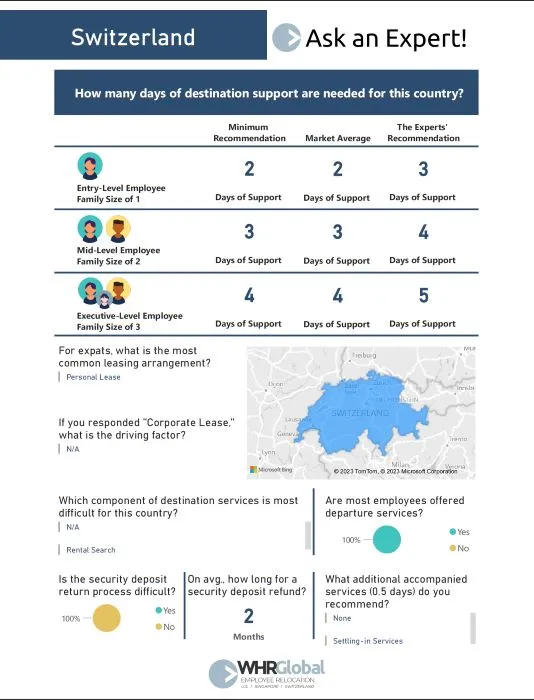
Has your organization strategically aligned your global mobility and talent acquisition stakeholders? Or do your teams feel siloed with different priorities and understandings? Read below to discover 6 ways to align global mobility and talent acquisition teams, including insights from Reda Belabed, GMS, a global mobility and immigration leader previously with Honeywell and General Electric, and WHR Global’s Head of Global Sales, Chris Lagerman.
If you feel your global mobility and talent acquisition teams aren’t working towards the same objectives, you’re not alone! Fortunately, there are several common-sense steps you can take to improve your talent mobility and ensure these stakeholders are working as a cohesive team.
When global mobility and talent acquisition teams are aligned, your highly specialized employees are hired quickly and compliantly.
1. Distribute “How To” Relocation Guides to your Global Mobility and Talent Acquisition Teams for Core Locations
Distribute “How To” guides to your talent acquisition and global mobility teams. These should be mission-critical things they must know for your company’s core locations, including immigration, tax, and recommended relocation support. For example:
-
-
- Your company regularly hires executives to work in your Netherlands Global Center of Excellence. Are your teams applying for the Netherlands’ 30% ruling? Is your talent acquisition team responsible for ensuring each applicant meets the 30% ruling’s requirements before presenting the job offer? For example, your talent acquisition representative must ensure the candidate has specific expertise, is recruited greater than 150 km from the Netherlands border, and more.
- Due to the highly specialized nature of your business, you are recruiting internal and external candidates for a position in the U.S. Is your talent acquisition team familiar with U.S. visa types, such as the L-1 visa for intracompany transfers, or the H-1B visa for specialty occupations? Your talent acquisition teams should know the basic requirements for each visa type before attempting to source foreign talent.
- Your RMC should proactively provide guidance on the level of relocation support needed by country for your core locations. For example, this 2023 Destination Services Benchmark Report indicates the minimum, average, and recommended level of destination support by country, family size, and employee level. The report also indicates if leases should be personal or corporate, how long it takes to receive a security deposit return, and which components are most challenging.
-
2. Review Talent Acquisition Metrics such as Time-To-Fill
Unfortunately, TA (talent acquisition) is not only measured based on the volume/quality of positions filled but mostly on the Time-To-Fill (TTF) which often widens critical gaps between the organizational needs, candidates’ experience and the tough reality of compliance.
I’ve implemented a cross-functional pre-assessment process for what I called “Immigration Hire-ability”, where permissible by law. Where it has been applied, I’m quite comfortable with the level of partnership it managed to increase between the two functions (and ultimately mitigate the risks of “bad hires”). In other places, Data Privacy regulations along with Fair-Employment Practices appeared to be hurdles to the implementation. There’s not a lot of flexibility when it comes to Labor and Employment, through Works Councils and the likes and it’s really been a challenge.
One of the plasters we have been focused on in these instances is increased (and repeated) training and education sessions with the recruiters to get them up-to-speed with “what they need to look out for/how to identify red flags” and review the overall communication strategy (up to offer accept), to enable all stakeholders to have a better understanding of the potential risks inherent to the hiring of Candidates on an immigration status and/or sponsorship requirements and responsibilities (incl. cost, timelines, immigration lifecycles, as well as talent management strategies).
I guess we’re all progressing but there’s still a long way before we can say we’re comfortable with the level of collaboration and partnership, with a 100% Candidate satisfaction, an improved TTF metric and a satisfactory pre-hire Immigration Compliance assessment.
3. Implement Pre-Acceptance Checkpoints to Increase Success Rates
As alluded to above, mobility programs can greatly increase the acceptance and success rates of assignments by implementing various pre-acceptance checkpoints.
-
-
- Retain the services of a reputable tax firm. In addition to country briefings for assignees, they can provide invaluable guidance to talent acquisition teams. At a minimum, ensure your talent acquisition teams are familiar with the concepts of tax assistance and equalization, and totalization agreements. to provide pre-acceptance tax briefings to all foreign applicants.
- For country-specific tax briefings, applicants should be aware of their options before accepting the position as any misunderstandings can greatly increase the risk of a failed relocation or assignment. Assignees (especially those within executive or director-level positions) may have complicated investment portfolios of stocks, stock options, bonds, real estate holdings, precious metals such as gold, and more. The employee’s options will vary greatly depending on the location, citizenship(s), and relocation type (permanent transfer, long-term assignment, short-term assignment, commuter, business traveler).
- As mentioned above in step 2, try to build your own cross-functional pre-assessment process (a.k.a. immigration hire-ability guide) where permissible by law. However, you should be cognizant of challenging jurisdictions such as the United States and European Union, as further detailed by Reda Belabed:
-
Countries like the US where questions can be limited to “will you or in the future require sponsorship” and other EU countries where requesting personal information/data can be considered as PII and a hinderance to fair employment practices/discrimination at hiring. Geographies like the Middle East (GCC, in particular) are more open to these assessments.
Authorities having a long history of foreign and diverse workforce tend to allow/promote the recourse to hireability checks based on sponsorship requirements but also advocating for more transparency in terms of “quotas”. Not that nationality quotas are something to condone, but the transparency around it helps the pre-determination of feasibility – instead of engaging with candidates through the offer stages only to discover it may not be possible. From an organizational standpoint, the process is quite transparent and streamlined.
4. Pre-decision Calls through your Relocation Management Company (RMC)
Your global mobility team and RMC may also choose to implement predecision calls. In relocation management, pre-decision calls ensure that the candidate understands the relocation package they’ll be receiving. However, it’s also an opportunity for your RMC to promote your company, your benefits package, and alleviate any concerns the employee or family may have.
Pre-decision calls also prevent discrepancies or misunderstandings once the employee accepts the offer and begins the relocation process. For example, after the pre-decision call the employee knows exactly which package they will receive, how much each relocation allowance will be, and more. Oftentimes there is a disconnect between the relocation package quoted by a talent acquisition or HR business partner compared to the relocation package actually implemented by the RMC. This may boil down to human error or someone operating on an old/outdated policy. These discrepancies can be minimized when the RMC is both explaining the relocation package pre-decision and implementing the relocation package post acceptance.

5. Optimize Your HRIS for Maximum Talent Mobility
Your organization can maximize its talent mobility by creating custom fields, objects, and reporting in your HRIS (human resources information system). For example, in ADP your organization can build and manage a talent pool of applicants who are willing to relocate for open positions. However, your organization shouldn’t overlook existing employees who are willing to relocate for an intracompany transfer. Existing employees should already understand your products, services, and expectations, thereby reducing hiring and training costs.
According to benchmarking by SHRM, the average cost to hire an executive is $28,329 USD. However many employers estimate the total cost to hire a new employee can be three to four times the position’s salary. This is a combination of hard costs, such as recruiters, and soft costs such as the time it takes for department leaders and managers to support the hiring and training process.
Instead of sourcing new candidates from scratch, speak with your IT department about adding custom fields, objects, and reporting to your HRIS system. Then, existing employees can indicate in their HR profile if they’re willing to relocate for a new position. Within the custom reporting, you can also add filters to narrow your talent pool to high-performing employees who are willing to relocate, combined with past performance reviews already loaded in the HRIS.
-
-
- How to create a custom field in ADP.
- How to create a custom object in Workday.
-

6. Conduct Regular Training Sessions With Talent Acquisition Teams
Regular training sessions ensure your talent acquisition teams have access to the same systems, resources, and responses to questions that are frequently asked by candidates pre and post-acceptance. Training sessions also provide new talent acquisition team members an opportunity to learn more about the mobility packages your employees are receiving and reinforce the message that all talent acquisition teams should follow the same standardized processes.
Relocation management companies regularly arrange training sessions with talent acquisition teams and relevant stakeholders to improve talent mobility. These training sessions can include:
-
-
- On-site training sessions from the relocation management company for mobility, TA, and HR teams. Depending on the size of your mobility program, your RMC may conduct these training sessions for free or just request your company to cover hotel and travel costs (depending on the distance and duration).
- Virtual webinar-style training sessions from the RMC.
- Country or region-specific training for your organization’s key locations, or locations presenting unique difficulties.
- Insights from destination services providers (DSPs) and rental agents around market updates, cultural norms, and best practices.
- Guidance from immigration firms on red flags, quotas, estimated timelines, minimum salaries, labor market testing requirements, and more.
-
We have achieved significant success in transitioning regional structures to a centralized global mobility program by conducting regular training sessions with talent acquisition leaders. These sessions primarily focus on journey maps and crucial considerations throughout the process. By actively involving regional TA stakeholders in discussions about mobility benefits and desired outcomes, we have observed a noticeable increase in their willingness to adopt standardized processes.
In conclusion, aligning global mobility and talent acquisition teams is crucial for organizations to ensure efficient hiring and successful talent mobility. By distributing relocation guides, reviewing talent acquisition metrics, implementing pre-acceptance checkpoints, conducting pre-decision calls, optimizing HRIS systems, and conducting regular training sessions, organizations can foster collaboration and enhance the effectiveness of these teams. Achieving alignment leads to the swift and compliant hiring of specialized employees, reduces risks, improves time-to-fill metrics, and ultimately enhances overall candidate satisfaction and immigration compliance. Continued efforts and investment in aligning these teams will contribute to a more streamlined and successful talent acquisition process.

